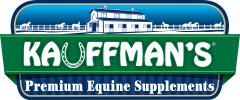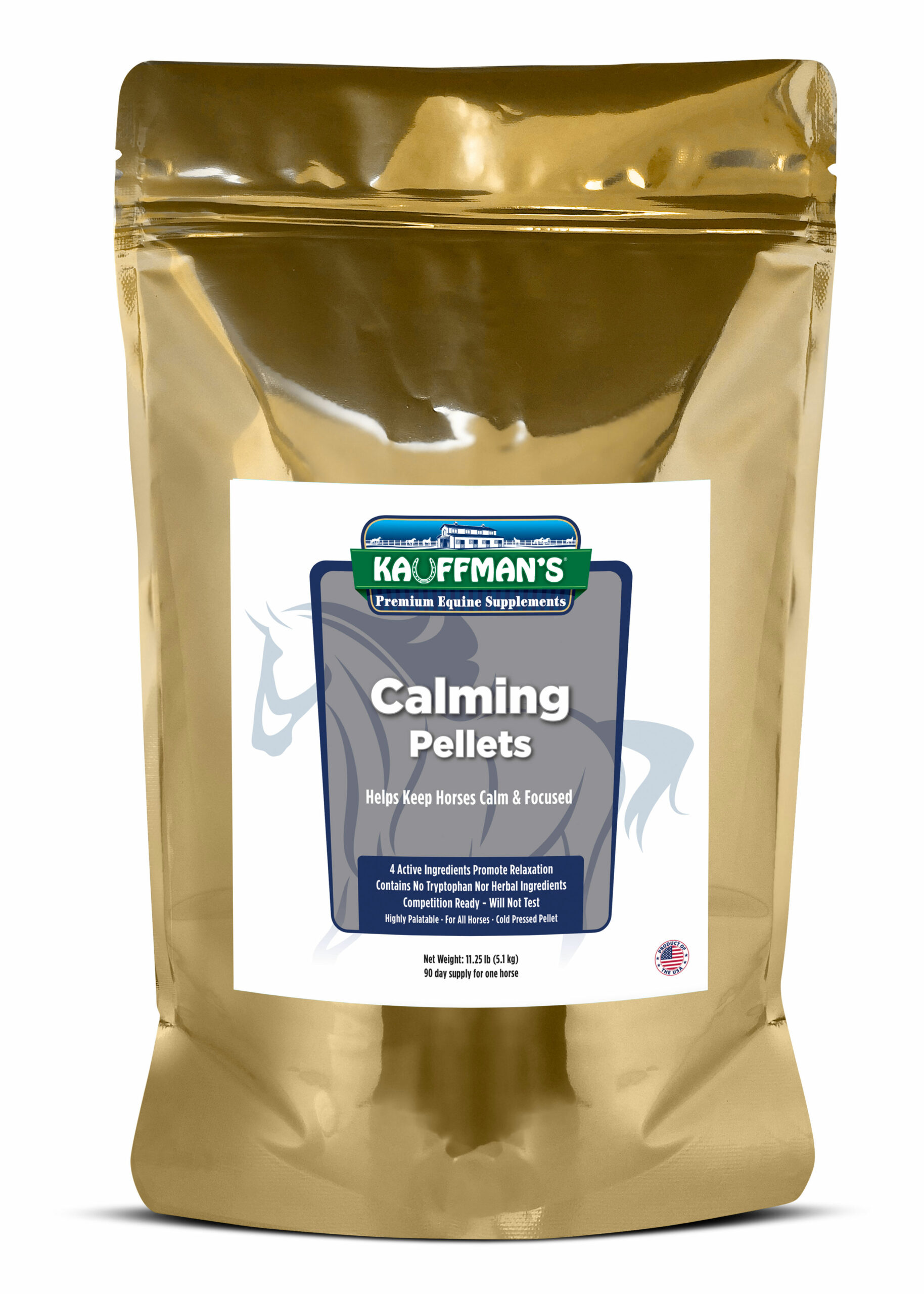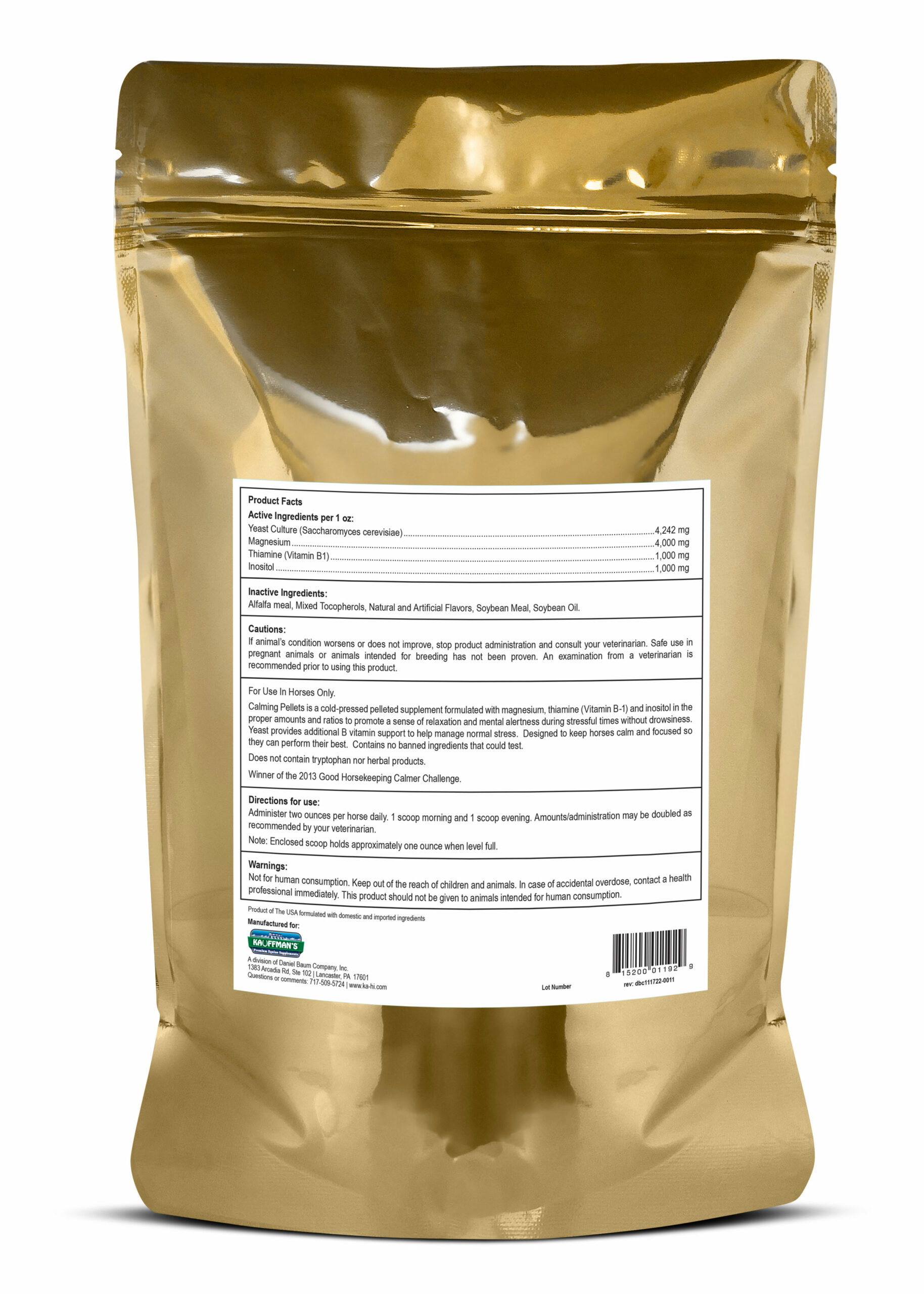Product Details
Winner of the 2013 Good Horsekeeping Calmer Challenge, KAUFFMAN’S® Calming Pellets™ contain three special ingredients that can help maintain a normal and relaxed disposition in equines of all ages and disciplines.
- Magnesium – essential mineral for sound neuromuscular function
- Vitamin B-1 (thiamine) –for energy metabolism and transmission of nerve impulses
- Inositol – assists with calming effect on nerves
Calming Pellets contains no tryptophan or herbals that may cause unwanted side effects. This is also very important if you compete with your horses and have to be cognizant of the drug testing your organization complies with. Rest assured the ingredients in Calming Pellets will not test at a competition.
It is recommended for transportation, competitions, training, foaling, farrier or vet visits and seasonal changes to promote relaxation and support balanced behavior.
Incorporate Calming Pellets into your equine athletes feeding regimen to support normal emotional balance and help maintain a normal, relaxed disposition.
Why Horses May Become Nervous
Incredibly sensitive to their environment, horses also have excellent memories that heavily influence the way they react to various external stimuli. Horses spent millions of years as free-ranging animals, only to be recently domesticated and have to adapt to modern feeding practices and confinement. Consequently, horses often exhibit what we might consider “problem” behaviors or stable vices that include cribbing, wood chewing, weaving and wind-sucking.
The natural environment of all horses is an open pasture. In fact, horses given free range in an unbounded pasture will graze more than 12 hours a day. With large hindguts and small stomachs designed for this type of all-day grazing, free-ranging horses will roam long distances while getting the ample exercise they need.
Contrast to this instinctive behavior with the way horses are now managed — today, they’re kept in enclosed areas such as stalls where they receive restricted meals instead of being allowed to graze. Once horses eat their meals, they have hours of “downtime” to fill. This significant reduction in grazing and feeding times may be a viable correlation between nervousness and dietary restrictions.
Environmental Stressors
Anything out of the ordinary can “spook” a horse such as cars, farm equipment, a helicopter flying overhead, fireworks or another animal, and this can keep them feeling nervous for a while after the encounter.
Many horses do not like entering dark places and may especially become agitated when left alone in unlit areas. Horses are herd animals that are accustomed to being around other horses. Fear of being left alone in horses is often expressed as barn-sour or buddy-sour behaviors.
Loud noises will make even normally calm horses stressed and nervous. It’s also common for horses to develop a fear of a particular noise but not be afraid of other noises.
Your Questions Answered
Soybean Meal, Magnesium Oxide, Yeast Culture, Alfalfa Meal, Soybean Oil, Thiamine Mononitrate, Inositol, Magnesium Proteinate, Mixed Tocopherols (a preservative), Natural & Artificial Flavor.
Adult Horses – feed at the rate of one (1) ounce per feeding (1 scoop). Ideally, top dress one (1) scoop Kauffman’s Calming Pellets over morning and evening feed to achieve two (2) ounce daily feeding rate. Daily feeding rate may be safely doubled.
Guaranteed Minimum Analysis
| Per lb. | Per 2 oz. | |
| Crude Protein, min. | 90.7 g | 11.30 g |
| Crude Fat, min. | 31.7 g | 3.95 g |
| Crude Fiber, max. | 22.7 g | 2.83 g |
| Magnesium, min. | 64,000 mg | 8,000 mg |
| Vitamin B-1, min. | 16,000 mg | 2,000 mg |
| Inositol, min. | 16,000 mg | 2,000 mg |
- Transportation
- Pre-Competition
- Training and Exercise
- Veterinarian, farrier, or dental visits



Reviews
There are no reviews yet.